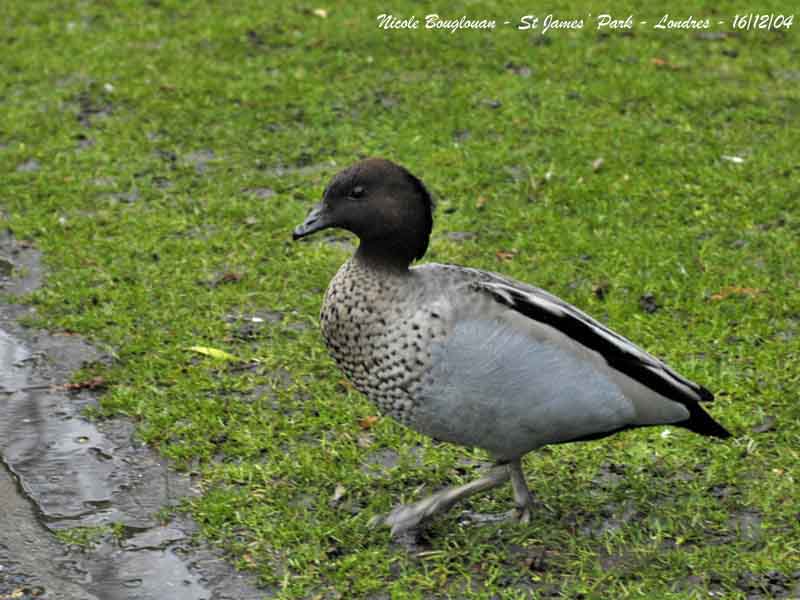
Australian Wood Duck
Chenonetta jubata
Anseriforme Order – Anatidae Family
BIOMETRICS:
Length: 44-51 cm
Wingspan: 80 cm
Weight: M : 815g – F : 800g
DESCRIPTION:
Australian Wood Duck looks like a goose in its attitude and feeding behaviour. It is endemic to Australia.

Adult male has pale grey plumage, with black back, belly and tail. Breast is heavily mottled with grey and black.
Wings are pale grey with black flight feathers, and secondary feathers very conspicuous in flight with bright green bases and white tips. Flanks are finely barred with grey.
Head is dark brown and shows a kind of black feathers tuft, from crown through the nape to the rear neck. Neck is dark brown.
Short bill is black. Eyes are brown. Legs and webbed feet are dark grey.
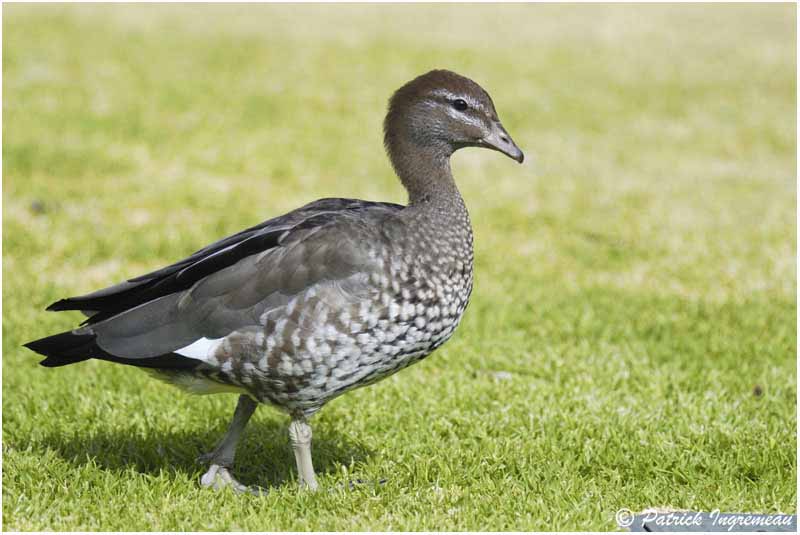
Adult female is duller than male. Underparts are mottled with dark brown. Her plumage is rather greyish-brown.
Head and neck are greyish-brown. We can see two white stripes on the face, from lores to ear coverts, one above and the other below the eye. Bill is paler than in male.
Juvenile is similar to female but paler, and with more streaks on breast.
VOICE: SOUNDS BY XENO-CANTO
Australian Wood Duck female utters in flight plaintive, long, raising “gnow” or “wrouw”, as mewing. Male has louder call, short and high-pitched.
When in flocks, birds “chatter” while feeding.
HABITAT:
Australian Wood Duck lives in open areas, grasslands, wetlands, open woodlands and flooded pastures. It also may be found in farmland with dams, rice fields, ponds and urban parks, and sometimes along the coasts, in small islands and bays. It prefers deep lakes, and forages also on land.
RANGE:
Australian Wood Duck is widespread in Australia, mainly in eastern and western parts, and also in Tasmania.
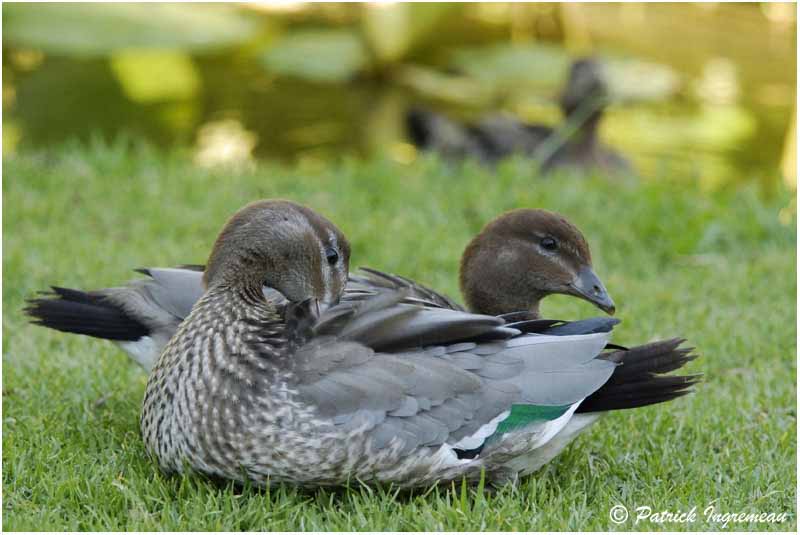
BEHAVIOUR:
Australian Wood Duck lives often in groups. It forages mainly by night, on the shores. This species feeds by grazing near water, and sometimes by dabbling. But it doesn’t swim very well, whereas it walks and runs easily.
During the day, Australian Wood Duck rests in flocks, perched on trees close water. They start to feed at dusk.
If threatened, Australian Wood Duck stays motionless, or disappears by walking or it takes off silently through the trees.
This species is usually sedentary, but some dispersion may be observed according to rainfalls and food resources such as grass.
Pair bonds are permanent, and family groups remain among flocks. Breeding season varies, according to rainfalls.
FLIGHT:
Australian Wood Duck flies fairly slowly and low through the trees if disturbed. In random manner, it can fly swiftly and easily. It is an accomplished flier.
REPRODUCTION:
Australian Wood Duck nests in cavities in trees or in nest-boxes above or near water. Nest is made with a pile of down.
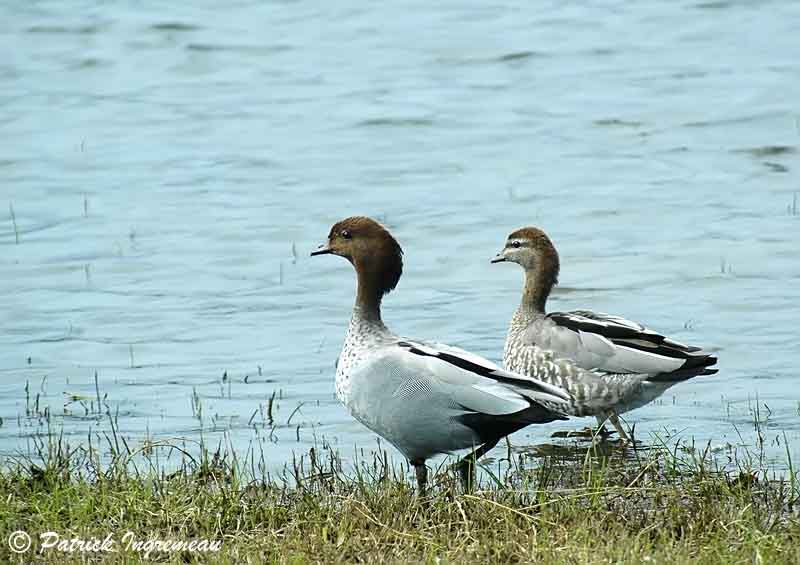
Female lays 8 to 10 creamy-white eggs. Incubation lasts about 28 days, by both parents, but male may guard the nest-site.
At hatching, chicks are covered with waterproof down which allows them to swim very soon. They are fed by both adults, and they remain in family groups for one month after fledging at about 50 days old.
Breeding season is from September to November in southern Australia and from January to March in northern parts. They can breed all year round in semi-arid regions.

DIET:
Australian Wood Duck feeds mainly on vegetation, such as grasses, clovers and others, and it may consume insects occasionally.
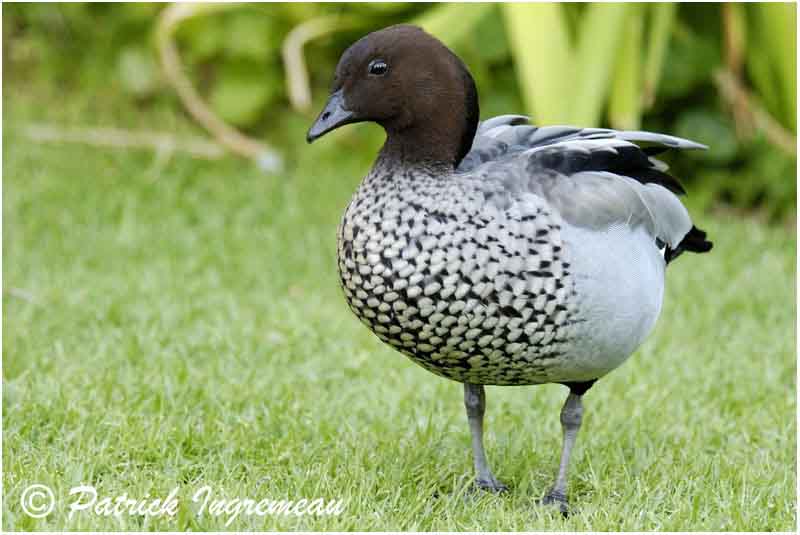
PROTECTION / THREATS / STATUS:
Australian Wood Duck is widespread in its range. This species has benefited from agriculture developments, with creation of dams and pools.
It is classified as game bird, and killed by hunters. It is also considered as pest, because it damages crops and pastures.
However, this species is not threatened, and numbers are stable.
Fr: Canard à crinière
All : Mähnenente
Esp : Pato de Crin
Ital : Anatra arboricola australiana
Nd : Manengans
Russe : Гривистая утка
Photographs by Patrick Ingremeau
TAMANDUA
Text and other pictures by Nicole Bouglouan
Sources :
HANDBOOK OF THE BIRDS OF THE WORLD vol 1 by Josep del Hoyo-Andrew Elliot-Jordi Sargatal - Lynx Edicions - ISBN: 8487334105
GUIDE DES CANARDS, DES OIES ET DES CYGNES – de Steve Madge - Delachaux et Niestlé - ISBN: 2603013769
Birds in backyards (Birds Australia and Australian Museum)
Wikipedia (Wikipedia, The Free Encyclopedia)
Arthur Grosset's Birds (Arthur Grosset)